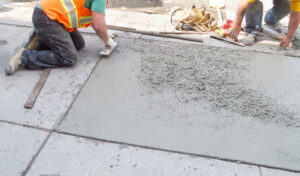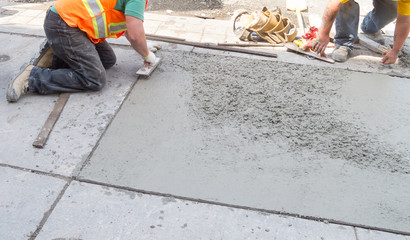Concrete is a popular construction material that can be used for sidewalks, commercial parking lots, and structural floor slabs. It’s known for its strength and durability, making it a great choice for large-scale projects.
Concrete Greensboro NC is made up of air, water, Portland cement, and aggregates, like sand or rocks. All of these ingredients must be properly proportioned for concrete to set correctly.
Concrete is one of the most common building materials, and it is well-known for its strength. In fact, a square inch of it can withstand 3,000 pounds of pressure. Its impressive strength makes it a popular material for constructing roads, highways, commercial parking lots and sidewalks. It is also a key ingredient in many other construction projects, including bridges, dams and high-rise buildings. It is a versatile material that can be mixed to generate varying degrees of strength, and it can be molded into many different shapes and textures to fit the needs of each project.
The cement in concrete acts as a binding agent, which helps to hold together aggregates such as sand, gravel or crushed stone. When mixed with water, it hardens through a process called hydration, when the cement particles react with water to create a paste. This paste is then used to bind the aggregates together to form the strong concrete that we know and love.
When reinforced with steel, concrete is even stronger. This type of concrete is often used to build tall skyscrapers, as it has the ability to withstand tensile and shear stresses that would otherwise cause the structure to fail. The combination of concrete and steel is also able to resist seismic loads and vibrations.
Another advantage of concrete is its longevity. It can last for decades, and it is resistant to fire, rot, rusting and weathering, making it an excellent choice for long-term use. It is also easy to repair and maintain, saving both money and time.
There are a number of types of concrete, and each has its own benefits. For example, rapid-strength concrete sets in a shorter amount of time than standard concrete, making it ideal for construction during harsh weather conditions. This type of concrete is made with admixtures that speed up the hydration and hardening process.
Regardless of the type of concrete, it is important to note that it must be properly mixed and placed to achieve its full strength. The mix must be well-compacted, and there should be no segregation or air pockets. This can be accomplished by using mechanical poker vibrators, which will ensure that the concrete is aerated and compacted without losing its plasticity.
Durability
Concrete is a durable building material, and can be used for a wide range of applications. It can withstand the harshest weather conditions and traffic loads, and can last for decades. It also resists corrosion and can be molded into different shapes. It is also environmentally friendly, and is a cost-effective alternative to other building materials.
Its durability is a result of several factors, including mix proportions, the type and condition of aggregates, admixtures, curing methods, and the environment to which the concrete is exposed. By addressing these issues, engineers can ensure that their structures are built to last for as long as possible.
One of the main concerns for concrete durability is permeability, which allows substances like chlorides and salts to migrate through the concrete, leading to deterioration and corrosion. This can be mitigated by using a low water-cement ratio, selecting suitable aggregates, and avoiding additives that can cause problems such as alkali silica reactivity (ASR). In addition to reducing permeability, the concrete should be placed properly and consolidated into a solid mass to avoid voids and weak spots.
Insufficient durability can lead to a significant increase in the life-cycle costs of a concrete structure. A structure with poor durability will need to be replaced more frequently, and may require extensive repairs and reconstruction. Conversely, structures with high durability can reduce embodied energy and maintenance costs, as well as the amount of construction waste.
Increasing the durability of concrete is crucial for sustainable construction, as it can help cut back on the use of fossil fuels and other resources that contribute to climate change. It can also help reduce costs for demolition and reconstruction, as well as save on operational expenditures. In addition, concrete can be recycled multiple times over its lifetime, which will further decrease its embodied impact. Additionally, it can help preserve cultural legacies and prevent environmental degradation of buildings. These benefits make concrete an incredibly sustainable building material. This advancement in concrete technology is helping to create more resilient cities around the world, making them safer, healthier, and more efficient.
Flexibility
Concrete is a very versatile building material. It can be molded into different shapes and used for decorative or structural purposes. It can also be poured in hollow forms to create a wide range of structures. It can also be reinforced to allow it to support large loads. In addition, concrete is very durable and can withstand fire, earthquakes, and hurricanes. Concrete also requires less maintenance than other building materials, making it a cost-effective choice.
Concrete has been in use for thousands of years, and engineers have been working to improve it ever since. They’ve developed a variety of new types of concrete that have specific properties for different uses. These improvements help to make concrete more sustainable for the future.
Engineers have discovered a way to make concrete more flexible, so that it can bend and flex like metal. They’ve developed a special mix called “bendable concrete.” It’s similar to regular concrete, but it has a much smaller percentage of aggregate, so that it can be shaped into a more delicate form. The concrete also contains fibers, which provide flexibility and strength.
Researchers have studied the structure of nacre, a type of seashell, to create this flexible concrete. By eliminating the coarse aggregate and adding more fibers, they’ve created a material that resembles nacre’s controlled slippage. This new concrete is still stronger than steel and can withstand earthquakes and hurricanes. It’s also easier to shape into different shapes on the construction site, which reduces the time and energy needed for fabrication.
The new concrete is being used in Japan, Korea, and the US. It’s a more sustainable option than steel, because it cures at normal temperatures and doesn’t need extreme heat to form into desirable shapes. It can also be molded into more complex shapes than traditional concrete, and it’s less likely to crack over time.
This new technology could save money and energy by reducing the number of times that roads need to be rebuilt. It might also make bridges and skyscrapers more resistant to earthquakes, which could save billions of dollars in repair costs.
Cost
Concrete is a versatile material that can be used to construct a variety of structures. Its strength and durability make it ideal for a wide range of uses, including roads, bridges and large-scale construction projects. Concrete is also resistant to fire and requires minimal maintenance, making it a cost-effective solution for building.
Cement is the key ingredient in concrete, and there are many different types of cement available on the market. The type of cement used in a project is determined by its application and the environmental conditions where it will be used. The most common type of cement is Portland cement, which is derived from limestone and other materials and then fired in a kiln to produce clinker. The clinker is mixed with water, aggregates and other chemicals to create concrete.
The main cost of concrete is the labor and equipment needed to mix, transport and place it on-site. It is a time-sensitive process, and the concrete must be put into place before it hardens. This is why ready-mix trucks are used, which maintain the concrete’s liquid state by agitation and constant turning of the drum. Several additives can be added to the concrete mixture to achieve specific properties, but these are usually only used for special purposes.
In addition to its strength and durability, concrete is also a sustainable material. It can be made using locally-sourced ingredients, which reduces shipping costs and emissions. It is also a good choice for seismic zones, as it can absorb some of the energy caused by earthquakes.
Another benefit of concrete is its low maintenance requirements, which makes it a great choice for outdoor spaces. It resists staining and fading, and is easy to clean and disinfect. It can also be treated with anti-fungal chemicals to prevent fungus and mold growth.
Concrete has been around for thousands of years, and it is still the world’s most widely used construction material. It is used to build roads, freshwater pipes, wastewater solutions and communication infrastructure, as well as housing foundations and walls. It is also a popular material for sidewalks and commercial buildings, and its durability means that it can last for centuries.
